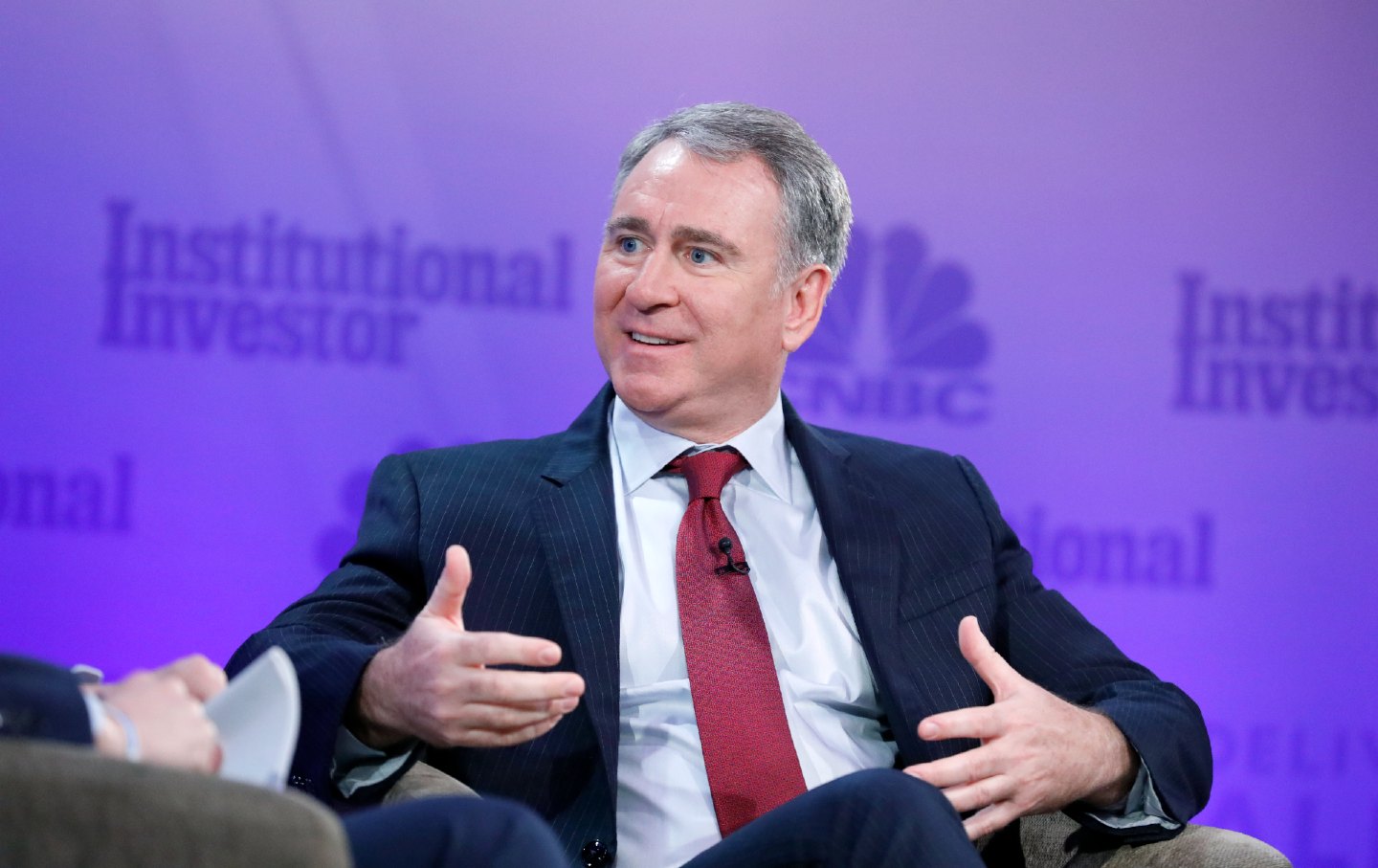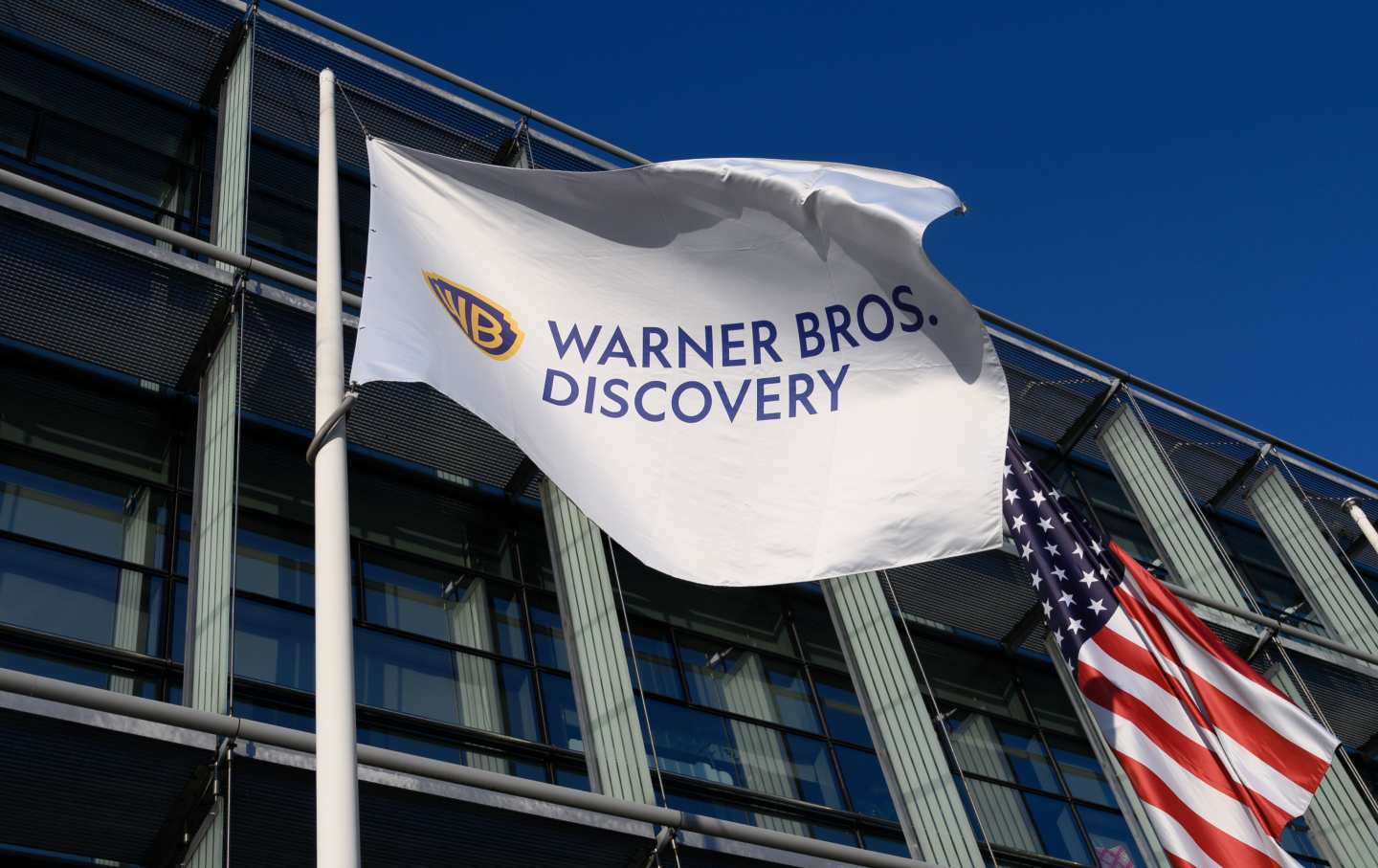If You Don’t Know Who Ken Griffin Is, You Should
How the press keeps us in the dark about the new Gilded Age.

CNBC’s Andrew Ross Sorkin interviews Kenneth C. Griffin, the founder and CEO of Citadel, at the CNBC Institutional Investor Delivering Alpha conference on July 18, 2018, in New York City.
(Heidi Gutman / CNBC / NBCU Photo Bank / NBCUniversal via Getty Images)
“AHedge Fund Chief Shakes Up the Industry” ran the headline over a front-page article in The Wall Street Journal in mid-August that anointed Ken Griffin as the nation’s most successful hedge fund manager. According to the Journal, the 55-year-old founder and chief executive of Citadel took an industry long dominated by star traders like George Soros and David Tepper and instead set up “scores of teams that semiautonomously manage their own portfolios.” Such diffuse investing factories are now “ascendant” in the United States, accounting for more than a quarter of hedge-fund jobs and 30 percent of the industry’s stock-market footprint. “We made more money than any firm has ever made in the history of capital markets,” Griffin told reporter Peter Rudegeair. “This is where people come when they want to change the world of finance.”
Drawing on conversations with more than two dozen people familiar with Griffin and his fund, the article recited his many superlatives: an estimated net worth of $42 billion; $75 million in contributions to conservative candidates and causes in the current election cycle; donations of hundreds of millions more to the Memorial Sloan Kettering Cancer Center and Harvard University, his alma mater (including a $300 million gift last year to its Faculty of Arts and Sciences ); a sprawling real estate portfolio; and the weeks Griffin spends each year “personally reviewing the impact that thousands of employees have had on the firm.” Rudegeair writes that portfolio managers who otherwise would have opened their own funds “have increasingly accepted offers from Citadel and its peers to run their own teams inside its walls.” In 2023, Citadel’s flagship fund notched a return of 15.3 percent, trumping such competitors as Millennium and Point72.
There was, however, an important fact missing from the piece. That 15.3 percent return on Citadel’s flagship, while indeed beating the competition, badly lagged the S&P 500, which rose 24 percent for the year. Had Citadel’s investors instead placed their money in a low-cost index fund tracking the broad stock market, they would have earned much more. Several readers derisively noted this in the comments section. “What lunatic invests in a hedge fund?” wrote Anthony P. “These folks can’t beat the market and get beat by retirees that have their own investing clubs.”
Wondering about the absence of such a significant data point, I wrote to Rudegeair, requesting an interview. He wrote back to say that he preferred to let the story speak for itself.
Left to conjecture, I can only assume that including the S&P 500 figure would have diminished Griffin’s glow. The article was accompanied by a color photo of Griffin showing him looking tanned and triumphant in his office in Miami. (Founded in Chicago in 1990, Citadel had long been based in that city, but in 2022 it moved to southern Florida because of Griffin’s concern over the level of violent crime in that city.) The Journal article exemplifies a certain genre of Wall Street reporting, in which world-bestriding financial and corporate figures are lionized for their wealth, acumen, and generous give-backs to society—a species that seems all the more jarring at a time when the top 1 percent of Americans own as much wealth as the bottom 90 percent and when more than a third of families say they would have trouble coming up with $400 in the event of an emergency.
Most people reading this article probably haven’t heard of Griffin and have little idea of what hedge funds are. They are pools of money entrusted by wealthy people and institutions to investment managers who promise them alpha—a return superior to that of industry benchmarks. There are around 3,800 such funds in the United States, managing $4.7 trillion. The sector is known for its swagger, secrecy, egotism, and ostentation. Prominent practitioners include Steve Cohen, Ray Dalio, Izzy Englander, David Shaw, and the late Jim Simons. (Others, such as Bill Ackman, Carl Icahn, and Paul Singer, belong to a subcategory known as hedge-fund activists.) They are pivotal figures in our new Gilded Age, in which the .01 percent have enriched themselves at the expense of wage-earning America and converted their fortunes into political influence, social status, and cultural capital. More Money Than God is the apt title of Sebastian Mallaby’s book about these men—and they are almost all men. And Griffin has outpaced them all. Every year, Institutional Investor compiles a list of the top 25 hedge-fund earners, and in 2022 Griffin placed first with a staggering $4.1 billion—the most in the list’s 22-year history.
In describing him and the industry, the Journal article left out some essential details. In its telling, Griffin created scores of teams to manage their own portfolios. Over time, Citadel came to look “less like a traditional hedge fund,” with a single manager overseeing all investments, “and more like a nesting doll of mini-hedge funds.” Griffin “opened additional stock-picking units, each composed of separate teams that were dedicated to certain sectors and managed their own positions.” By 2018, such multimanager funds “were growing faster than the rest of the industry and starting to account for its biggest launches.” With the proliferation of “copycat firms” mirroring Citadel’s strategies, Griffin “is now focused on maintaining his edge,” tending to even such minor matters as trade-processing errors. “Once a firm makes it clear they tolerate complacency anywhere,” Griffin observed, “it’s pretty easy for it to spread everywhere.”
The Journal, however, failed to note a critical factor in the firm’s competitive edge: its technology. Citadel uses superfast computers and advanced statistical models to guide its investment strategies. Though many hedge funds today operate in this way, Griffin was in the forefront, as another Journal reporter, Scott Patterson, chronicled in his 2010 book, The Quants. In contrast to Warren Buffett and other old-school investors who picked stocks based on their personal assessment of a company’s growth potential and other “fundamentals,” Patterson wrote, Griffin was among the best and brightest of a new breed of math-whiz technocrats who used a data-driven, algorithmic approach to detect small fluctuations, price discrepancies, and emerging market trends in a fraction of a second. As trading became increasingly automated, Citadel and other Wall Street firms scooped up mathematicians, physicists, engineers, and data scientists. These technologists have worked closely with portfolio managers, investment analysts, traders, and risk managers to develop complex investment strategies in equities, fixed income, credit, and commodities.
Today, there’s a steady flow of technologists from Silicon Valley to Wall Street, where they can earn millions or even tens of millions of dollars a year. Citadel employs more than 250 PhDs in 60 fields ranging from statistics and bioinformatics to aeronautics and atmospheric science. By many accounts, however, Citadel is a grueling place at which to work, thanks to Griffin’s unforgiving management style and Darwinian focus on performance.
Another ingredient in Citadel’s success is its fee structure. Most hedge funds have traditionally used a “2-and-20” structure, charging the fund’s outside investors a management fee of 2 percent of all assets and a performance fee of 20 percent of all profits. Citadel, by contrast, charges all of its expenses to its investors, including compensation, rent, research, and technology, amounting to around 7 percent of total assets. Such sky-high fees enable Citadel to invest more in computers, programmers, and portfolio managers than most other funds.
Parallel to his hedge fund, Griffin operates a separate market-making division called Citadel Securities. When an investor places an order with an investment manager like Fidelity or a brokerage like Charles Schwab to buy or sell stock, those companies send it to a market-maker like Citadel Securities to execute it. The firm operates banks of computers that—located on the premises of NASDAQ and other exchanges around the world—can buy and sell stocks at speeds a hundred times faster than the blink of an eye, allowing it to get a jump on the competition. Today, Citadel Securities is the largest such executor of stock orders in the country, accounting for a remarkable 35 percent of all daily retail trades. The profit on each transaction is a fraction of a cent, but with Citadel Securities executing more than $450 billion in trades every day, the aggregate total is massive, and Citadel Securities is now a major source of Griffin’s wealth.
To be fair, Citadel’s flagship fund over the years has handily outperformed the S&P 500. Since January 1, 2020, its cumulative rate of return has been more than double that of the S&P. But most hedge funds have fallen woefully short of that benchmark, and some pension funds—disappointed with their returns—have abandoned them. Warren Buffett has long criticized hedge funds as a terrible investment. In 2007, he bet that a low-fee Vanguard S&P 500 index fund would, over a 10-year period, outperform a portfolio of hedge funds selected by an independent advisory firm. In the end, he collected: The index fund increased by 85 percent and the hedge funds by just 22 percent.
Popular
“swipe left below to view more authors”Swipe →As awareness has spread that you can’t beat the market, trillions of dollars have moved from actively managed funds like hedge funds into passive funds that try to mirror the market. Yet many universities, foundations, and high-net-worth individuals continue to pile into hedge funds. In 2023, Harvard placed a whopping 31 percent of its $50-billion-plus endowment in such funds. Its overall return for the year was a paltry 2.9 percent—about one-eighth the increase in the S&P 500. Harvard’s average annual return for the 10 years through June 2023 was 8.6 percent, second from the bottom of Ivy League universities. Yet N.P. Narvekar, the head of its endowment committee, continues to pull down more than $6 million a year, making him Harvard’s highest-paid employee. Why endowment committees continue to favor hedge funds despite their abysmal performance reflects the heavy presence on those committees and their advisory boards of executives from hedge funds and private equity firms, who dole out business to their Wall Street contacts—a glaring form of favoritism that journalists rarely explore.
Nor do journalists spend much time examining the power of hedge-fund billionaires like Griffin and the distorting and destabilizing effect their wealth has on American society. In the political sphere, Griffin belongs to a class of financier megadonors who since Citizens United—the 2010 Supreme Court decision that struck down many limits on campaign contributions—have flooded the political system with money. In 2014, when Citadel was still based in Chicago and Griffin was the richest man in Illinois, he backed the gubernatorial candidacy of his friend Bruce Rauner, a private-equity executive who shared Griffin’s resolutely free-market views and support for charter schools. The $5.5 million he gave Rauner’s campaign helped him eke out a narrow victory. As governor, Rauner pushed for deep cuts in social services and higher education that made him deeply unpopular, and, despite the astounding $20 million that Griffin donated to his 2018 reelection campaign, Rauner was trounced by his Democratic opponent, J.B. Pritzker, who, as a billionaire, was able to outspend him.
When in 2018 Ron DeSantis ran for governor of Florida, Griffin contributed $5.75 million to his campaign, making him its largest backer. He donated another $5 million to his 2022 reelection bid, helping him to outspend his Democratic opponent. Griffin’s cash thus played a key role in electing two conservative governors. In the current election cycle, he is the second-largest donor in the country, with most of his money going to support Republican House and Senate candidates, including $10 million to back the senatorial bid of Larry Hogan in Maryland. (Griffin backed Nikki Haley during the Republican primaries.) “I’ve never seen anything like it,” a Republican fundraiser told the Financial Times about Griffin’s giving. “The amount of power he has is unbelievable.”
Griffin’s philanthropic donations are even more colossal. As with many in his bracket, he favors elite institutions and insistently seeks naming rights to help advertise his generosity. In Chicago, one can visit the Griffin Halls of Evolving Planet and Sue the T. Rex at the Field Museum; the Renzo Piano–designed Griffin Court at the Art Institute of Chicago; the Griffin Galleries at the Museum of Contemporary Art Chicago; and the Kenneth C. Griffin Museum of Science and Industry, to which he gave $125 million. In 2017, Griffin gave another $125 million to the economics department of the University of Chicago, which was renamed the Kenneth C. Griffin Department of Economics. At Harvard, not only the Graduate School of Arts and Sciences but also its financial aid office (to which he gave $150 million) are named after him.
In New York, there’s a Griffin Hall at the Whitney Museum of American Art, a Griffin Building at the Museum of Modern Art, a Griffin Theater at the performance space The Shed at Hudson Yards, and the Griffin Exploration Atrium at the newly expanded American Museum of Natural History. Citadel’s representatives (who patiently responded to my many questions) made sure I knew about the $30 million that Griffin gave last year to the National Medal of Honor Museum Foundation in Arlington, Texas, to underwrite a leadership institute, now known as the Griffin Institute. Griffin has also supported children’s hospitals, neuroscience research and cancer care, K-12 education (public, private, and charter), and Miami Dade College ($20 million to establish a Griffin Scholarship Fund for low-income students). Over the years, Griffin has contributed $35 million to Success Academy, the controversially strict charter network that operates nearly 50 schools in New York. Without the support of ultrarich hedge-fund executives like Griffin, Success and other charter schools would have a hard time surviving.
In all, Griffin has given away more than $2 billion. Most of that money qualifies for tax deductions, which for someone in Griffin’s bracket could total around $600 million in federal taxes alone—money that is diverted from the public treasury. Taxpayers are thus helping to subsidize his philanthropy without having any say in where it goes. (ProPublica found that from 2013 to 2018, Griffin paid 29.2 percent of his earnings in federal income tax—the fourth-highest rate among the 15 highest income-earners in those years.)
Griffin has also spent lavishly on art. He is one of a small group of collectors whose outlandish payouts for trophy works have driven up their prices, helping to make even our wealthiest museums dependent on their whims and goodwill. In 2015, Griffin bought Willem de Kooning’s Interchange for $300 million and Jackson Pollock’s Number 17A for $200 million from fellow multibillionaire David Geffen—the most expensive art deal ever. Those and other Griffin purchases had for years hung in the Art Institute of Chicago, but when Griffin decided to move Citadel to Florida, he had the works taken down and moved to the Norton Museum in West Palm Beach. Every year, Griffin makes the ARTnews list of the top 200 collectors, which confers prestige and acclaim in a phenomenon known as art-washing.
In no area has Griffin spent more obsessively than real estate. Just to list the properties in his portfolio is to provide a snapshot of a society that seems profoundly unwell. They include a luxury penthouse apartment in Chicago, for which he paid $58.75 million in 2017 (the most ever for a residence in that city); an oceanfront property at the Four Seasons Hualalai resort in Hawaii; a pair of adjacent homes in Aspen, Colorado, with a combined total of 12 bedrooms; two penthouse apartments in a luxury condo in Miami Beach; a collection of lots in Palm Beach for which he paid $350 million and on which he plans to build a grand estate; a seven-acre oceanfront estate in Southampton that he bought from fashion designer Calvin Klein for $84.45 million; a Georgian mansion near Buckingham Palace in London that cost $122 million; and a three-floor penthouse at 220 Central Park South in New York for which he paid $238 million—still the highest price paid for a residence in the United States. When asked about this, Citadel (as part of an eight-page fact sheet) provided this statement: “Ken has mostly purchased one of a kind, iconic properties and oceanfront lots which are inherently of limited supply, and therefore likely to be sustainably valued. One of those Palm Beach properties has a house in progress for his mother.”
Sad to say, Griffin is not an isolated case. Hedge-fund and private-equity billionaires typically own four, five, six, or even more premier residences in prime locales in a stomach-turning case of competitive consumption. At a time when an estimated 650,000 Americans are homeless and the nation faces a housing shortfall of several million units, such gluttony seems a good advertisement for a robust wealth tax.
The scale of Griffin’s fortune and the influence it brings raises a broader issue that business reporters rarely broach: How much social utility do hedge funds have? The evidence suggests they have very little. The universities and retirement funds that have poured billions into these funds have in most cases gotten much poorer returns than they could have by shunning them. During the recent wave of protests on college campuses, hedge-fund executives (along with their private-equity colleagues) used their power as major donors to oust Ivy League presidents. (In January, Griffin said that he was pausing his gifts to Harvard, calling its students “whiny snowflakes” and chastising elite universities in general for being “lost in the wilderness of microaggressions” and pursuing “a DEI agenda that has no real endgame.”) With their superfast trading, hedge funds have fed the short-term mindset that has so eroded the long-term productivity and prosperity of American companies. And all those highly trained engineers, mathematicians, and physicists that are helping firms like Citadel reap billions could be more productively employed developing new treatments for chronic diseases, improving the nation’s transportation system, and creating a more efficient energy grid.
Above all, these funds have widened the gulf between the ultrarich and the rest of us. A few years ago, The Washington Post calculated that the top 25 top hedge-fund earners together made more than the nation’s 158,000 kindergarten teachers combined. Not since the days of the robber barons has such a small group controlled such vast wealth, and the SEC should appoint a panel to explore ways to constrict these funds so that people like Griffin have less income than God. Maybe then journalists would start paying more attention to them.
Disobey authoritarians, support The Nation
Over the past year you’ve read Nation writers like Elie Mystal, Kaveh Akbar, John Nichols, Joan Walsh, Bryce Covert, Dave Zirin, Jeet Heer, Michael T. Klare, Katha Pollitt, Amy Littlefield, Gregg Gonsalves, and Sasha Abramsky take on the Trump family’s corruption, set the record straight about Robert F. Kennedy Jr.’s catastrophic Make America Healthy Again movement, survey the fallout and human cost of the DOGE wrecking ball, anticipate the Supreme Court’s dangerous antidemocratic rulings, and amplify successful tactics of resistance on the streets and in Congress.
We publish these stories because when members of our communities are being abducted, household debt is climbing, and AI data centers are causing water and electricity shortages, we have a duty as journalists to do all we can to inform the public.
In 2026, our aim is to do more than ever before—but we need your support to make that happen.
Through December 31, a generous donor will match all donations up to $75,000. That means that your contribution will be doubled, dollar for dollar. If we hit the full match, we’ll be starting 2026 with $150,000 to invest in the stories that impact real people’s lives—the kinds of stories that billionaire-owned, corporate-backed outlets aren’t covering.
With your support, our team will publish major stories that the president and his allies won’t want you to read. We’ll cover the emerging military-tech industrial complex and matters of war, peace, and surveillance, as well as the affordability crisis, hunger, housing, healthcare, the environment, attacks on reproductive rights, and much more. At the same time, we’ll imagine alternatives to Trumpian rule and uplift efforts to create a better world, here and now.
While your gift has twice the impact, I’m asking you to support The Nation with a donation today. You’ll empower the journalists, editors, and fact-checkers best equipped to hold this authoritarian administration to account.
I hope you won’t miss this moment—donate to The Nation today.
Onward,
Katrina vanden Heuvel
Editor and publisher, The Nation
More from The Nation

One Buyout After Another One Buyout After Another
The multibillion-dollar takeover bids targeting Warner Bros. Discovery show how Trump’s corrupt model of governance-by-payback could destroy Hollywood.

The Grim Spectacle of Trump’s Gaudy Saudi Summit The Grim Spectacle of Trump’s Gaudy Saudi Summit
A weeklong debauch brought together tech insiders and the leaders of a brutal monarchy to keep stoking the AI bubble.

What Does Lina Khan’s Trust-Busting Mean for New York City? What Does Lina Khan’s Trust-Busting Mean for New York City?
Under-scrutinized monopolies—like the fire truck oligopoly—hinder municipal functions.

A Brief History of Right-Wing Attacks on Food Stamps A Brief History of Right-Wing Attacks on Food Stamps
A trip through The Nation’s archives offers essential insights into why Republicans have long tried to weaken SNAP—and why they’re trying to kill it now.

Trump Has Just Condemned More Americans to Hunger Trump Has Just Condemned More Americans to Hunger
The administration’s decision to fast-track a bunch of changes to food stamps—including new work requirements—is as stupid as it is cruel.

Trump Drops the Hammer on Farmworkers Trump Drops the Hammer on Farmworkers
At the end of the season, he cuts wages of 400,000 workers by a third.


